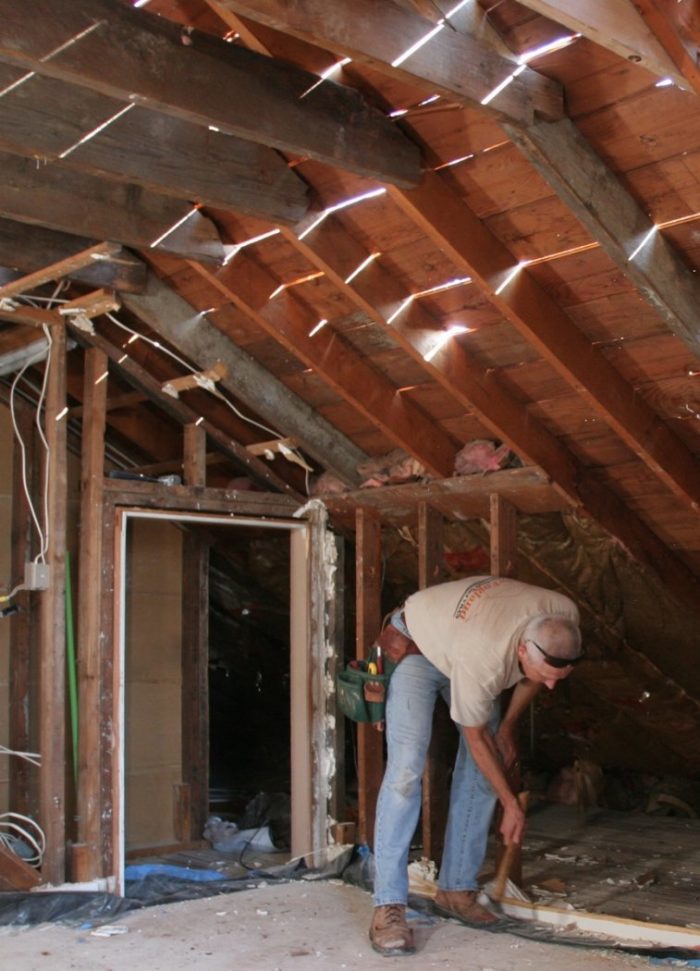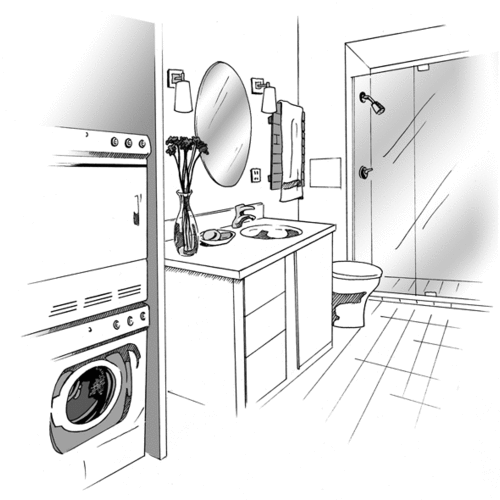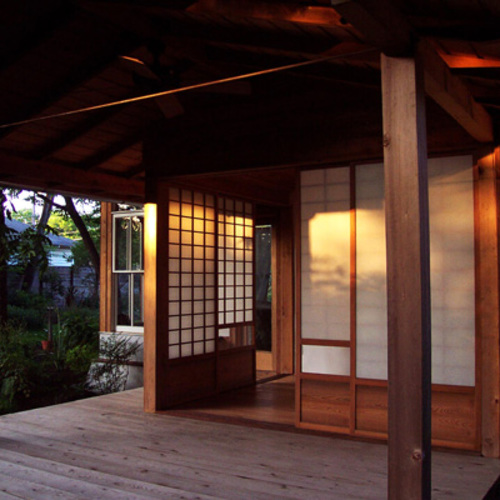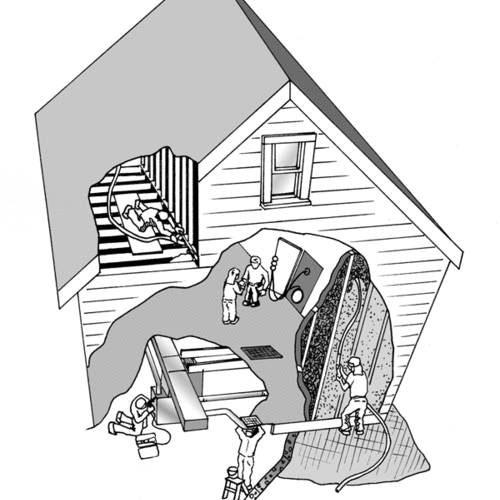Tearing out everything down to the studs offers lots of green options.
Gutting a building down to its frame can be a good green way to get a fresh start while the walls, floors, ceilings and roof are opened up. Questions about insulation, air sealing, and utilities disappear once you can see everything. A green rehab should focus on bringing the interior up to contemporary standards for form and function while honoring how the building has survived.
During demolition, consider reuse, recycling and land fill options for all the materials that are removed from the house.
Look for the hidden gems, and beware of the hidden hazards
Reusing materials is normally a great strategy for conserving resources, but only if the result is a high-performance building — energy- and water-efficient, durable, and healthy. Environmental quality is a paramount concern both during and after a gut rehab because many older buildings contain hazardous materials.
Consider integrating existing elements into the new design
Old buildings tend to have many layers, so it’s easy to miss some of the gems from the original design that might be brought back to the surface. Not all older buildings have historical architectural features that are worth preserving, but it’s worth exploring the possibility.
Check for contaminants
Old buildings often conceal contaminants: lead paint, asbestos, mold, pesticides, and coal dust. Finding out whether they are present, and safely abating them may require the help of a trained professional.
Search out moisture problems
Larger air leaks are usually obvious, and therefore easy to identify and fix. But older houses may have many smaller air leaks that are difficult to detect. In a drafty house, such leaks may cause building materials to dry out more quickly. But if a house is tightened up and insulated, the moisture equilibrium may be disturbed.
Integrate mechanical systems into the new layout and structural framing if possible
Opening up floor plans can change the dynamics of heating and cooling. Mechanical systems can also be affected by the orientation of floor framing, the dimensions of interior walls and chases, and the locations of bathrooms and kitchens. Create a plumbing core in the new floor plan by “stacking” bathrooms, kitchens, and laundry rooms. A more efficient building envelope may allow for smaller or less heating and cooling equipment and more efficient duct and plumbing runs. It may be possible to replace outdated central heating and cooling equipment with less expensive and more efficient spot heating and cooling.A Green Gut Rehab Case Study:
MORE ABOUT GUT REHABS
OTHER CONSIDERATIONS
Design strategies for a gut rehab should include minimizing demolition and construction waste, choosing more durable materials, installing an effective air barrier, and testing for hazardous materials. If existing ductwork is reused, seal it off to keep it free of contaminants during construction.
Foundation
If necessary, install a radon mitigation system. Insulate the floor slab and foundation walls.
Building envelope
Control bulk moisture–the flow of water through holes, cracks, and other discontinuities into basement walls. Air-seal the building carefully. Superinsulate the walls from the inside or outside, and use formaldehyde-free insulation. If necessary, replace existing doors and windows with energy-efficient versions. Minimize materials with advanced framing practices, and specify the use of FSC-certified framing, sheathing, and siding.
HVAC
Design mechanical systems for efficient distribution. Specify high-efficiency appliances. Avoid ozone-depleting refrigerants. Vent all combustion heaters.
Plumbing
Reconfigure plumbing to distribute hot water efficiently, and insulate hot-water lines. Consider an on-demand, tankless water heater.
Case Study

Starting with the bare walls
As difficult as it is to become homeowners in New York City’s perpetually tight housing market, Alicia and David finally managed to purchase a brownstone in Harlem. The trashed and stripped structure needed a complete makeover, including a new roof, new windows, insulated exterior walls, interior walls, and new HVAC, plumbing, and electrical systems. Despite a tight budget, the experienced green design team and actively engaged homeowners created an elegant, daylit townhouse with a spacious kitchen, low-emitting materials, and numerous green amenities.
Design Notes

Image Credits: Robert Politzer/REGREEN
The goal was a healthy green home.
Convinced of the value of building green, and with David having suffered lifelong allergies, the couple was invested in creating a healthy and environmentally friendly home. Both the contracting team and the homeowners accepted building green on a budget as a design challenge. The team viewed the whole process through the lens of environmental impact, carefully considering energy efficiency, indoor air quality, and environmentally friendly materials. In selecting each product, the homeowners took care to ask whether a greener product could be found.
Systems

Image Credits: Robert Politzer/REGREEN
Key Systems
General design and construction
*50% demolition and construction waste recycling
Building Envelope
*Formaldehyde-free batt insulation
*Modular green roof
Plumbing
*Dual-flush toilets
HVAC
*Whole-house fan and ducted air-conditioning system
*Kitchen and bathroom exhaust
*Radiant floor heating system throughout
*High-efficiency hot water and space heating, including Flat plate hot-water radiator, which collects solar radiation that heats a coolant, which in turn heats water or the home
Lighting
*Extensive daylighting
*Compact fluorescent lighting
*Automated controls
Equipment
*Energy Star appliances
Wall and Ceiling Finishes
*Bamboo and natural slate flooring
*Low-VOC caulks, paints, and adhesives
*Fasteners (not adhesives) to minimize VOCs
*Zero-VOC clay finish made from reclaimed stone, natural pigments, and soy binder
Furniture and Fittings
*Recycled-content countertop
Lessons

Image Credits: Robert Politzer/REGREEN
Sweat equity cuts costs
Like many homeowners on a budget, David and Alicia did the demolition work themselves. Although the structure was filled with moldy drywall and trash, it was free of lead paint and asbestos; improper abatement of these hazards can pose ongoing problems.
Info/Finance

Team and Process
The design-build team and the homeowners worked closely together throughout the project. David and Alicia researched green products.
Location: New York City
Homeowners: Alicia and David Basche
Design-Build Team: Robert Politzer, Hanna Purdy, and
Nick Moons of GreenStreet Construction, Inc.
Area affected: 3,500 ft2
Finance
The homeowners knew it would be a challenge to tackle this extensive gut rehab on a budget. How to creatively address budget constraints while achieving their aesthetic and green goals was a major component of the conversation from the start. Their answer to budgetary surprises was to pitch in even more of their own labor, rather than compromise on quality. Partly for this reason, the project took two years to complete.
Bird’s-Eye View
Green Points
LEED for Homes Gut rehabs are eligible to pursue LEED Home certification; many points are easier to earn, e.g., points in MR2.2 (Materials & Resources) for salvaged materials.
NGBS-Remodel Refer to the ANSI standard and follow the appropriate path based on conditioned floor area involved in the remodeling or addition project and the year in which the original home was built. NGBS










6 Comments
Advice on a new development
Hi there , I have 16 ha of rural land which I am trying to develop. There are no services in the area because of its location and electricity supply is an issue . So I am looking for some advice on building a whole sustainable village from the design stages .
Mike
sounds interesting and
sounds interesting and promising. I'd say small homes perhaps methane, solar and wind energy.
Food gardens permeable surfaces maybe a building for making things to sell... ceramics cloths ect
CML Rehaps and going Green
I am a neophyte to this but am embarking on a renovation and reuse of a 1926 era Masonic Lodge and Theatre in NC. My tentative non-green rehab budget only approx. $500k. However, am very curious and interested in rehabbing completing green (or as close to 100% as possible). I think it would be a key differentiator and large step to convert a historic theatre as a green building. Perhaps it is not possible but I am trying to source information from anyone that can help. Please email me if you have suggestions for where to look, funding sources, ideas, suggestions, criticisms. THANK YOU
Andrew
gut rehab/rebuild
Iam working on a fifty's build house with brick ext. and its in miss. and has had severe termite/water vapor damage. Everythings going except the brick ext. Going to close up all the vents in crawlsp and put new TGI's for flooring and fac truss's with a storage pl for furnac and h2o htr. My question is if I cover the inside of the brick with 3/8-1/2 mortar and spray foam and put insulation in the walls and attic and vent the attic like Dr. Joe says and have a conditoned space for the furnace. This would really keep things driy and possibly put a dehum in cwlsp? I plan to put in hvr system.
Response to Kirk Marcussen
Kirk,
We need to know more information.
Is this a load-bearing brick wall or brick veneer?
response to martin
Its brick veneer, Well, its been a real job doing this but, I like doing it. The house is almost 48' x 24' it was built in stages at different times. I am supporting the roof with 10' jack posts and going to have a crane lift off the roof in sections next month. In one section I already have the old roof sitting on new walls that are on the new floor. So far I have had no problems with anything, than a lot of work. O, maybe missing footers for the mudsills in the center section, that I redid and are matching with the new floor. On the walls I think they call it parging its the coating that Iam putting on the brick I got an Ideal from a friend to put some fiberglass in the mix. I knock off the weep on inside to make a smooth wall when I coat it, I sprayed closed cell foam on some walls in the crawl space area and didnt take off the weep, that was a mistake because it created pockets of air and indifference when spraying and it didnt go on very smooth. With the weep knocked it should make a real nice diff. I was wondering if anyone had done any projects like this before? Can I put in some pics? thanks kirk
Log in or create an account to post a comment.
Sign up Log in